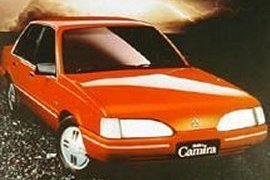




He Holden Camira was a mid-size car produced by Holden, the Australian subsidiary of General Motors (GM) between 1982 and 1989. It was Holden's version of GM's J-body family of cars—GM's third "global" car platform. After an initial good sales run, Camira sales dropped significantly, and was discontinued in 1989. The Holden Apollo, a rebadged Toyota Camry was introduced as the Australian market replacement, with New Zealand instead offering the European-sourced Opel Vectra. In all 151,807 Camiras were built. The original Camira, the JB series, was introduced in 1982 with a major trans-Tasman marketing campaign. The Camira replaced the Sunbird and Torana, although an interim four-cylinder version of the Commodore bridged the two-year production gap.
A station wagon version was introduced the following year, and its bodywork was exported to Vauxhall in the United Kingdom for the Cavalier wagon.[2] Some Camiras were also exported to right-hand drive markets in Southeast Asia, such as Indonesia and Singapore. The wagon variant was specifically a Holden design, and was actually a major demand Holden had in the overall "J-car" program. A five-door hatchback, based on the Opel Ascona/Vauxhall Cavalier "J-car" was proposed for the Camira, however due to Holden's financial losses at that time it never made production. There was only one engine, the carburettored, naturally-aspirated, transversely-mounted 1.6 litre four-cylinder engine delivering 64 kilowatts (86 hp). The transaxle offering was a four-speed manual on the SL and SL/X, with a five-speed unit specified to SJ and SL/E variants. A three-speed automatic with lockup torque converter was optional on the base model, but standard on the SL/E.
The Camira was Wheels magazine's Car of the Year for 1982. While superior to most other cars of the day in terms of ride and handling, the 1.6 litre Camtech engine was regarded as "underpowered" by much of the motoring media, and the Camira suffered from a litany of quality control issues which included smoking engines in early models, lack of drainage holes in the doors, paint quality and lack of adequate fan cooling resulting in overheating in Camiras fitted with air conditioning. This tarnished the Camira's reputation. Camira first came out as the JB series in August 1982 and promptly received a car of the year award, mainly because the judges loved its Euro-like handling and feel. A world car in the General Motors empire, it was built in Australia but carried a fair bit of imported design. This meant that in some ways it wasn’t totally suited to local conditions, particularly in the outback.
These mid-size Holdens have a good cabin with space for four/five adults if they don’t mind juggling the seats to make space for one another. There’s a large luggage area, with the Camira station wagon being a particularly good load carrier. In November 1984, while it was still flying high on the new-car scene, the Camira received a rather controversial sloped-nose facelift for the JD version. Holden backed off and the shape became more conventional in style with the JE in April 1987. Initially all Camiras were four-door sedans. In April 1983 a spacious five-door station wagon was added to the range. Interestingly, the wagon was an Australian design (the sedan was penned overseas) and all wagon rear ends were built here, even those sold in European markets.
A station wagon version was introduced the following year, and its bodywork was exported to Vauxhall in the United Kingdom for the Cavalier wagon.[2] Some Camiras were also exported to right-hand drive markets in Southeast Asia, such as Indonesia and Singapore. The wagon variant was specifically a Holden design, and was actually a major demand Holden had in the overall "J-car" program. A five-door hatchback, based on the Opel Ascona/Vauxhall Cavalier "J-car" was proposed for the Camira, however due to Holden's financial losses at that time it never made production. There was only one engine, the carburettored, naturally-aspirated, transversely-mounted 1.6 litre four-cylinder engine delivering 64 kilowatts (86 hp). The transaxle offering was a four-speed manual on the SL and SL/X, with a five-speed unit specified to SJ and SL/E variants. A three-speed automatic with lockup torque converter was optional on the base model, but standard on the SL/E.
The Camira was Wheels magazine's Car of the Year for 1982. While superior to most other cars of the day in terms of ride and handling, the 1.6 litre Camtech engine was regarded as "underpowered" by much of the motoring media, and the Camira suffered from a litany of quality control issues which included smoking engines in early models, lack of drainage holes in the doors, paint quality and lack of adequate fan cooling resulting in overheating in Camiras fitted with air conditioning. This tarnished the Camira's reputation. Camira first came out as the JB series in August 1982 and promptly received a car of the year award, mainly because the judges loved its Euro-like handling and feel. A world car in the General Motors empire, it was built in Australia but carried a fair bit of imported design. This meant that in some ways it wasn’t totally suited to local conditions, particularly in the outback.
These mid-size Holdens have a good cabin with space for four/five adults if they don’t mind juggling the seats to make space for one another. There’s a large luggage area, with the Camira station wagon being a particularly good load carrier. In November 1984, while it was still flying high on the new-car scene, the Camira received a rather controversial sloped-nose facelift for the JD version. Holden backed off and the shape became more conventional in style with the JE in April 1987. Initially all Camiras were four-door sedans. In April 1983 a spacious five-door station wagon was added to the range. Interestingly, the wagon was an Australian design (the sedan was penned overseas) and all wagon rear ends were built here, even those sold in European markets.



No comments:
Post a Comment